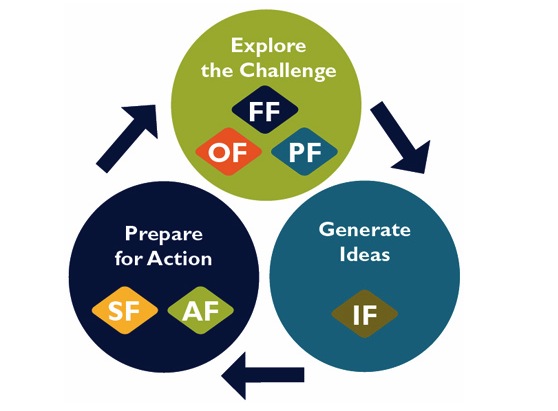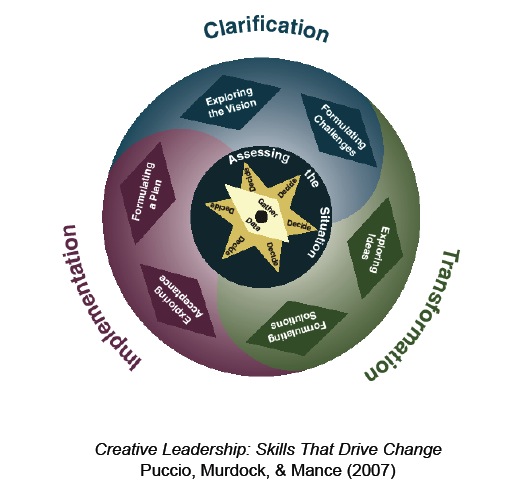Which Creative Problem Solving Model Do You Use?
Do you offer creativity services? Do you teach or facilitate individuals and groups to get new ideas and make new decisions?
People who do often know the value of creative thinking and how anyone can develop their creative skills by using a range of techniques. They know what prevents and encourages creativity, how to generate more and better ideas, find imaginative solutions to problems and discover ways of breaking through thinking blocks.
New thinking can be approached through a variety of methods. One is the Osborn-Parnes model of Creative Problem Solving (or CPS). The process is a structured, step-by-step method designed to approach problems or challenges in imaginative and innovative ways, exploring different options and finally formulating a plan of action for exciting new futures. A variety of techniques used throughout CPS can be applied to a variety of situations in work and life.
There are a at least four models for the Osborne-Parnes Creative Problem Solving Process, which do you use?
Creative Problem Solving Models à la Osborn-Parnes
Linear
I studied the linear Osborn-Parnes process at the International Center for Studies in Creativity with its founder Dr. Sid Parnes. In the 1970’s we thought in straight lines, taking one step at a time to maintain order, channeling freedom. We affectionately called it the accordion model because it looked like one. The diamond shapes Sid would remind us, represent first diverging or generating options, and then choosing a refreshed focus before moving on.
Bubble – Multiple Entry Points
In the 1990’s CPS morphed into connected bubbles reflecting shifts in attitudes toward meaningful and directed connectedness. The channeled freedom from 2 decades earlier is given wider birth. The bubble model shows three unique stages. Visually it implies permission to enter in at any part of the process, not only at the beginning as the 1970’s model above. Notice the diamond shapes have smoother edges, arrows give directions and the three bubbles tell you exactly what to do.
Systemic – Thinking Skills
Research and development of the CPS model continues transforming approaches to using it. The newest version, Thinking Skills Model, appears as a system with multiple entry points depending on the situation or the task at hand (centre hub). It’s construction corresponds with our current view of the world – interrelated, web-like. It shows the unique essence of each stage through renaming them (for further info, see Creative Leadership Skills that Drive Change).
The accordion and bubble CPS models provide logical rational approaches to CPS, giving overt direction; the thinking skills iteration lets you know what occurs. It outlines the three main stages and maps the thinking processes used for each. Notice the diamonds stay, the three main focus points connect in fluid colours and the starting point depends on situational need.
What’s next?
Research on a newer CPS model by Cyndi Burnett and Janice Fransisco integrates affective or feeling domains in the process reflecting again, a shifting world view, valuing the human spirit for creative outcomes.
Summary
All CPS models are effective guides for new thinking and action; each extends beyond the foundational brainstorming. The first is a linear flow, the second is logical and bucketed in a series of three main stages, and the third has incumbent thinking skills to extend beyond the usual. The fourth overtly taps into how people feel as they deal with increasing ambiguity and complexity in a spirit of being open to new results and creating change in behaviour, output, and processes.
Which is best if you had to choose? The one that works for you.
You can learn Osborn-Parnes CPS at Creative Problem Solving Institute, held each June. They use the bubble model.
" onclick="_gaq.push(['_trackEvent', 'outbound-article', 'http://del.icio.us/post?url=http://wp.me/pURBb-5Z&title=', 'Del.icio.us']);" title="Add to Del.icio.us" rel="nofollow" target="_blank">Del.icio.us | " onclick="_gaq.push(['_trackEvent', 'outbound-article', 'http://www.stumbleupon.com/submit?url=http://wp.me/pURBb-5Z&title=', 'Stumbleupon']);" title="Add to Stumbleupon" rel="nofollow" target="_blank">Stumbleupon | " onclick="_gaq.push(['_trackEvent', 'outbound-article', 'http://reddit.com/submit?url=http://wp.me/pURBb-5Z&title=', 'Reddit']);" title="Add to Reddit" rel="nofollow" target="_blank">Reddit | " onclick="_gaq.push(['_trackEvent', 'outbound-article', 'http://www.blinklist.com/index.php?Action=Blink/addblink.php&Description=&Url=http://wp.me/pURBb-5Z&Title=', 'Blinklist']);" title="Add to Blinklist" rel="nofollow" target="_blank">Blinklist | " onclick="_gaq.push(['_trackEvent', 'outbound-article', 'http://twitter.com/home/?status=', 'Twitter']);" title="Add to Twitter" rel="nofollow" target="_blank">Twitter | Technorati | " onclick="_gaq.push(['_trackEvent', 'outbound-article', 'http://buzz.yahoo.com/buzz?targetUrl=http://wp.me/pURBb-5Z&headline=', 'Yahoo Buzz']);" title="Add to Yahoo Buzz" rel="nofollow" target="_blank">Yahoo Buzz | " onclick="_gaq.push(['_trackEvent', 'outbound-article', 'http://www.newsvine.com/_wine/save?u=http://wp.me/pURBb-5Z&h=', 'Newsvine']);" title="Add to Newsvine" rel="nofollow" target="_blank">Newsvine " onclick="_gaq.push(['_trackEvent', 'outbound-article', 'http://getsociallive.com/gslike.php?likeurl=http://wp.me/pURBb-5Z&liketitle=', '']);" title="Like This!" rel="nofollow" target="_blank">




[...] 16, 2010 by marcisegal Even though many creative processes are represented in simple ways (see Which Creative Problem Solving Model do you use) this map by Viruscomix shows more of the life inside the experience, including the self-doubt, the [...]
[...] creativity mean to you, your boss, your clients?Creativity and bullying – is there a relationship?Which Creative Problem Solving Model Do You Use?Creative Process Map – the truth inside the experienceFresh thinking on creative process: Honing [...]